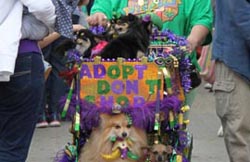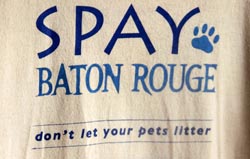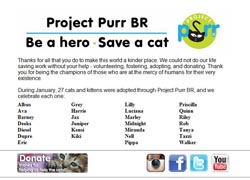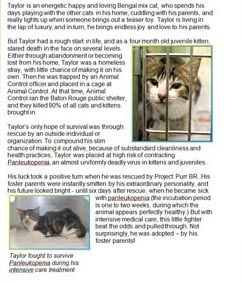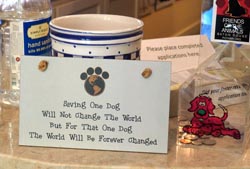In Noah's Footsteps: Traditions of Animal Rescue Groups in Baton Rouge
By Carolyn Ware

Traditions of Animal Rescue Groups
Whether they work alone, as part of a small, private network, or as members of a larger organization, animal rescue workers have many traditions that demonstrate their deep love of animals, the challenges and satisfactions of their work, the importance of the human-animal bond, and belief in the value of animal lives. Being a shelter or animal rescue worker, veterinarian Lorie Huston blogged, is often thankless, and "No matter how many animals you help, there are always more that need your help. And when you are unable to help, the situation is even more heartbreaking" (Huston 2014). Baton Rouge rescuers similarly describe their work as "heartbreaking" and "aggravating," but also rewarding. Traditions help to build and reinforce a sense of community and shared purpose among rescue workers, and to validate the reasons and worth of their efforts.
Some folk traditions are specific to a particular individual or organization, but many are common among local rescuers. Baton Rouge animal rescuers share a body of occupational terms and expressions that reflect their experiences, shape how they understand their work, and mark them as a member of the rescue community. Means of transmission vary; some traditions are shared face-to-face at adoption events, work days, and other gatherings, while others are disseminated to the public by social media and other means.
The Language of Rescue Work
Like all work groups, animal rescuers have a special vocabulary that reflects "the totality of [their occupational] experience" (Santino 1989:3). Some terms are shorthand references to the animals members rescue. "Dumps," for example, are the many animals—often young puppies or kittens—abandoned in public parking lots, remote rural spots, trash dumpsters, or other places. Animals taken from the public "kill" shelter (that is, one that must euthanize some healthy animals because of overpopulation) by a rescue group are "pulled" by a "pull team," and the animals themselves become "pulls." "Foster fails" are an ironic reference to the common situation of a foster caregiving falling in love with an animal they are fostering; unwilling to give it up, they adopt the animal themselves. The term can also be a shorthand way of referring to the animal itself. "My dog is a foster fail" communicates this special relationship to those familiar with the term.
Other expressions describe the complications of taking care of a foster animal, including monitoring its health. Foster kittens are said to have "good poop" (firm feces that indicate digestive health) or "bad poop" (soft, unformed feces or diarrhea that may necessitate a change of food or a deworming).
Currently, one of the most common language traditions is the use of animal-related puns, which is both a form of playfulness and a marketing tool. The popular term for an adoptive home—a "forever" home—becomes a "fur-ever" home in written form, for example. Cat rescue groups devise puns around feline features, so a perfect home might become a "purr-fect" home. Organizational slogans like "Every tail deserves a happy ending," printed on t-shirts and promotional materials, are another form of attention-getting word play.
Pithy slogans also offer opportunities for creative expression. Cat Haven's "Give a cat a 10th life" makes its point by referring to a traditional belief that cats have nine lives, and suggests that adopting a homeless cat can give it a new and better chance, an extra life. Project Purr's "Be a hero—save a cat" similarly encourages the reader to make a heroic choice by adopting a rescued cat.
T-shirts are a common way of displaying these slogans and other animal welfare sentiments. Many groups sell shirts with their logos, slogans, and other messages to simultaneously raise funds and raise their public profile. Some shirts cleverly adapt popular culture references to make their point. A local humane group designed a t-shirt with lyrics made famous by the popular television show The Big Bang Theory, for example. The lyrics of "Soft Kitty, Warm Kitty," a favorite lullaby of one of the show's main characters, gains new rescue-related lines on the shirt: "Rescue kitty, saved kitty, purr, purr, purr."
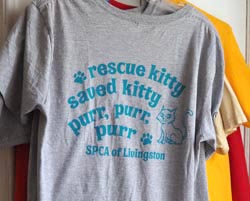
Individual animal rescuers also create their own new sayings, using traditional formulas such as similes. A rescue group member who pulls adoptable cats and kittens from the public shelter says that she always takes as many kittens as she can, because "kittens are like Jello. You can always squeeze another one in" (SPCA of Livingston volunteer 2015).
Naming Traditions
Another tradition, finding appealing names for adoptable animals, has both aesthetic and functional dimensions. Cats and dogs frequently come to a rescue group without names, or in the case of animals pulled from the CAA shelter, a temporary shelter name. One of the first things a rescue organization does, then, is to find a new name for the animal. Folklorist Tami Harbolt suggests that this act of naming homeless animals, especially those in public shelters, has considerable symbolic meaning. A pet's distinctive personality is typically obscured in a municipal animal shelter, where the animal is "nearly stripped of the meanings and definitions with which her owner had represented her" (2002:18). Animals themselves are often active participants in reconstructing their stories, through their personalities and interaction with rescuers (Harbolt 2002, Alger and Alger 2003).
The first step in reconstructing the animal's story and identity is finding an appropriate name. Perhaps the name itself is not ultimately important—after all, new owners are likely to re-name the pets they adopt—but the act of finding an appropriate name marks a new beginning, and establishes the animal's distinctiveness and value. Volunteers and foster caretakers try to find a name that suits the animal, perhaps based on its color, markings, other physical characteristics, or personality. Some foster caregivers feel very strongly about being able to choose a name for a new foster. When Project Purr recently tried to raise public awareness of its adoptable cats by inviting people to suggest names for specific cats online, the idea was unpopular with some foster parents and was dropped.
On a practical level, rescued animals' names, like their "bios," are intended to attract the interest of potential adopters. The name must be engaging and positive because "No one is going to adopt a cat named 'Howler'" (Decker 2015). Different rescue groups, and the individual volunteers, may have their own preferences and aesthetics. Cat Haven founding member and Executive Director Wendy Decker observes that while many organizations tend to name cats "animal" names such as Tiger or Fluffy, Cat Haven volunteers often favor human names. Depending on who is doing the naming, and what generation they belong to, names may refer to popular culture figures such as Game of Thrones characters or other familiar icons. The best Cat Haven names, Decker says, come from volunteers who have young children and know all the popular Disney characters that draw the attention of children (Decker 2015).
Organizations taking in hundreds of animals a year must be particularly inventive and quick in thinking up names. Often there is a playful element to the naming process. Thematic names can help, especially for a litter of kittens or puppies. Seasonal names, Paula Schoen (2014) says, are easy. At Christmas time, new dogs arriving at FOTA are likely to be named Donner, Blitzen, or related holiday names. Louisiana culture also provides a thematic thread, with names such as Boudreaux or Thibodeaux. So does the state's geography; a recent litter of kittens at Cat Haven were named after Louisiana parishes. Individual volunteers' interests and hobbies also offer ideas. At times, FOTA dogs have been named Reba, Hank, and other names of popular country performers. Literature-loving volunteers may name their foster animals after characters in classic (or obscure) novels.
Candy Ray, Operations Manager at Cat Haven, says that with almost 800 cats a year being admitted to the program, she and volunteers seek inspiration in unconventional places. Recently at a loss for ideas, she grabbed a Starbucks menu and named a litter of kittens after coffee drinks (2015). Other Cat Haven kittens have been named for the four directions (North, South, East, West), and alcoholic drinks (Margarita, Daiquiri). Volunteers understand, however, that these names are likely to be temporary, and once the pet is adopted, the new owner is likely to choose another name that is meaningful to him or her.
Narrative Traditions: The Animal's Story
A variety of other narrative traditions, formal and informal, are also important in animal rescue folklore. Whenever animal rescuers get together, they share conversational stories about their own pets, but especially about their foster animals, as they seek advice from other caregivers, describe breakthroughs, and relate funny incidents. Other stories are more formulaic. Among the most common and important kinds of narratives are what might be termed "life history stories" of rescued animals; some rescuers who write these narratives call them bios. Short versions are often shared verbally—everyone wants to know the story of how an animal came to be abandoned or surrendered, and how it was rescued—but increasingly life history stories are written and disseminated on social media. Reconstructing these histories, often from very little information, is an essential piece of re-establishing the animal's identity, as Harbolt argues (2002).
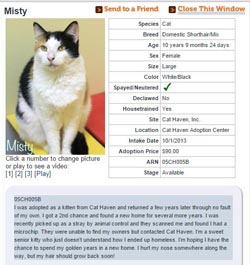
As with any kind of narrative, certain factors determine whether a particular animal life history story is considered good or effective. A good story gives potential adopters as much information as possible, Wendy Decker says, but also has "a little bit of a hook" that grabs attention. After all, the writers of these histories want to emphasize that "anybody who adopts this kitty [or dog] is saving a life" (Decker 2015).
Short versions of the life story may be typed onto intake forms, as at Cat Haven, where each cat is accompanied by a document with identifying information such as age, breed, color, and sex, and a short, first-person account of how it came to be at Cat Haven. This bio usually includes important details (when available) about whether the cat is used to dogs and other cats, its personality traits, and so on. Similarly, bios for dogs in the FOTA program give as much information as possible in four or five lines, so that people visiting the FOTA website or Pet Finder know not only how big the dog is, but something about its personality and history.
CAAWS takes a slightly different, humorous approach to sharing the stories of its "cats and dogs of the month" on the organization's website. These first-person life histories may be phrased as personal want ads, for example. A cat named Opie describes himself as a "Fella of five years of age seeks similarly independent human to reside with. . . . He would like for you to know that he is boss, and if he says your lap is his, it is" (CAAWS 2015). This narrative is a humorous—and fond—tribute to cats' determination to do exactly what they please, a trait that many cat lovers accept and even admire.
Rags to Riches Stories
Some of the most poignant stories are "rags to riches" stories that trace a rescued animal's journey transformation from unwanted, ill, and frightened animal to beloved pet. These stories of rescue and redemption reveal the resiliency of abused or neglected animals, and convey the importance of animal welfare efforts far more effectively than statistics can.
A 2015 Project Purr fundraising letter gives a particularly dramatic example in the story of Taylor, an "energetic, happy and loving" Bengal mix cat who began life as a homeless kitten and "stared death in the face" several times. When he was four months old, Taylor was trapped by Animal Control and taken to the parish shelter, which at that time had a euthanasia rate of about 90% of incoming cats. He was rescued by Project Purr but then developed a life-threatening illness from a virus he may have been exposed to in the shelter. The "little fighter beat the odds and pulled through" his illness and was adopted by his foster parents. Today he is "living in the lap of luxury, and in turn, he brings endless joy and love to his parents" (2015). This story not only describes the satisfactions of fostering and adopting a needy cat, but the steep odds Taylor had to overcome. Like most stories in the Baton Rouge area, it reminds the reader of the life-or-death urgency of finding homes for animals who otherwise face euthanasia.
For obvious reasons, detailed versions of these stories are often used in fundraising campaigns. But volunteer groups also celebrate these successes among themselves, with bulletin boards filled with photos of happy adopted pets in their new homes, and letters and cards describing these once-unwanted animals as beloved family members. These successes and happy outcomes, a rescuer says, are "what keeps you going" (Decker 2015).
Other stories that rescuers share privately with each other reveal the difficulties and uncertainties of animal welfare, factors that contribute to a high burnout rate among volunteers. Rescuers sometimes have to make hard judgment calls about whether a prospective adoptive home is suitable for a particular animal, for example. Sometimes adopted dogs and cats end up back in public shelters, abandoned by adopters with unrealistic expectations. Some narratives address conflicting claims of ownership. For instance, they may describe an emaciated, injured dog arriving at a rescue facility, rescue volunteers placing him in a foster home and watching him thrive, and then getting a call from someone claiming to be the dog's owner. Aside from legal issues, the rescuer agonizes over whether reunion is the animal's best interest. In these cases, rescuers often have to go on "a gut feeling" about the animal's welfare (Schoen 2014).
A Parable
Animal welfare workers also tell other kinds of stories to explain why they do what they do. The work can be overwhelming, especially as the problem of too many unwanted animals never goes away. Wendy Decker of Cat Haven says that the challenges are "never-ending. It's never-ending. You think you're getting somewhere, then you have a mild winter, and in May you have with 150 kittens and have to say no" to people who want to surrender kittens (2015).
Cindy Peterson of Hokies' Hounds says that when people ask why she persists in rescuing beagles, she is reminded of "the starfish story," in which a man walking along a beach comes across many starfish lying on the sand, dying. As he walks along, he tosses a starfish in the water, and then another one. A passerby by tells him that he can't make a difference by throwing back one or two starfish. The man says, "Well, it made a difference for that one." The lesson of this story, Mrs. Peterson says, is that "You have to do one [animal rescue] at a time. Focus on what you can do and do it well and ethically. Do it to the best of your ability. Focus on what you are doing, and the animal in the middle of that. Everyone can do something" (2015).
The Rescuers' Stories
Among the most powerful work-related stories are those of rescuers' journeys to animal work. These personal experience narratives often address how and why a rescuer became involved in the work, what it means to them, and their strong connections to animals. Often there are spiritual overtones, and some rescuers refer to their desire to help animals as a "calling." Paula Schoen says, "It's definitely spiritually based for me. " When she pulls a dog from the animal shelter, "The whole thing is to bring a dog out and let them come to you—you can see their minds work. There's immediate peace as soon as they walk out of the shelter. Their true self comes out. It brings a lot of peace." She adds, "I lose a lot of sleep at night, but I feel that this is what God wants me to do, this is my calling. This is where I want to be" (2014).
Schoen's FOTA colleague Sharon Coleman suggests that animal rescue is "something you're almost born to . . . something in your heart" even if "it takes time to awake to it" (2015). She says, "It's something that is in my heart that I have to do, that gives me peace and joy." At the end of the day, she likes to think about and talk to the dogs that she's placed in their homes. One day, after death, she'll see them again, she says (2015).
The idea that people and beloved animals will be reunited after death is a widespread one among those who love animals and are committed to helping them. The website for Gulf South Golden Retriever Rescue features a memorial page to remember special dogs who have "left paw prints on our hearts and are waiting for us on the Rainbow Bridge" (June 2015).
Special Events
Animal rescue groups plan and produce a variety of events that combine socializing and celebration with the practical goals of getting animals adopted and raising funds. These events, large and small, can take on traditional aspects for group members, as well as offering opportunities for sharing stories and other folklore. Some of the more public events draw on calendar customs such as costumed holiday parades. The annual Mystic Krewe of Mutts event and other animal-themed Mardi Gras parades borrow the symbols of South Louisiana's Carnival season—colorful and comical disguises, a royal court, "throws" for onlookers, and decorated floats—to celebrate the human-animal connection and to spotlight animal welfare. Similarly, rescue groups also stage costumed gathering for other holidays. One example is Project Yelp!'s "Yappy Halloween Run" on North Boulevard Town Square, which recently featured dogs costumed as football players and cheerleaders, and a goat led by its owners dressed as a goat herder. In addition to raising money for Yelp!BR, the Halloween run is a reunion for Yelp "alumni," as owners bring the dogs they have adopted from the organization for the five-kilometer run or the one-mile costumed "stroll" (Bethencourt 2014). Formal gala balls serve as fundraisers for groups such as the Companion Animal Alliance, which held its fourth annual Fur Ball in May 2015. Like Mardi Gras celebrations, the event featured its own royal canine court (Bordelon 2015). Other animal-rescue events include silent auctions, raffles, and various casual get-togethers like CAAWS' "Yappy Hour," which takes place every third Friday at a community dog park.
Weekend adoption fairs in public places also serve a valuable purpose, introducing adoptable animals—and animal rescue groups—to the general public. Adoption days require hard work of volunteers, who must set up tables, transport caged animals and supplies, and staff the area for much of the day. For some volunteers, adoption days can also be enjoyable social events, opportunities to visit with rescue friends and other people who stop by their table. Those who foster kittens or puppies looking forward to "finally showing how great our babies are to the public" at adoption days (SPCA staff member 2015). Rescue volunteers also find it rewarding when they can share their expertise with visitors who seek their advice on matters such as how to help two cats get along with each other.
Conclusion
Animal rescue volunteers and groups play essential roles in animal welfare in the Baton Rouge area, and they have made tremendous strides toward improving the lives of thousands of animals. Although their focus is on the dogs, cats, and other animals they seek to protect, their influence on human beings is equally profound; it helps to "maintain a bond between our species" (Harbolt 2002:23) by reminding us of the importance of human-animal relationships.
Despite the frustrations of animal rescue in the American South, rescuers say that it is rewarding to work with other people who are passionate about animals. Working together, groups can achieve a "ripple effect" (Decker 2015) that reaches father than any one organization can.
The primary reward, according to some rescuers, is finding a suitable home for an animal and receiving photos from the new owner, showing the animal under the family Christmas tree with bows in its fur, for example (Coleman 2015). Beagle rescuer Cindy Peterson may speak for all animal rescuers when she comments that saving one animal may not change the world or solve all animal-related problems, "but it will change the world for that animal" (2015).



